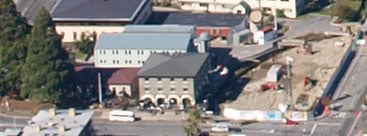Olympus E-3
-
-
Written by Gordon Laing
Olympus E-3 versus Nikon D300
Olympus E-3: JPEG versus RAW
|
We photographed the scene here in RAW + Large Fine JPEG mode and have presented crops below from each file for comparison. The RAW file was converted using Adobe Camera RAW using its default settings, saved as a 16-bit TIFF, then opened in Photoshop. This was then reduced to 8 bits and processed the same way as the original JPEG for presentation here. The RAW conversion has taken a slightly different approach to the tone and sharpening, but otherwise they’re quite similar results. As always, the benefit of shooting in RAW is being able to further tweak the settings and apply more sophisticated processing, but as seen here and throughout our review, the E-3 can certainly produce some very pleasing images using its in-camera JPEG processing and default settings. Now to see how the camera performed under studio conditions, check out our Olympus E-3 resolution results. |
Olympus E-3 JPEG with Zuiko Digital 12-60mm 1:2.8-4 SWD |
Olympus E-3 RAW with Zuiko Digital 12-60mm 1:2.8-4 SWD | |
 |  | |
f8, 100 ISO |
f8, 100 ISO |
Olympus E-3 results continued…
 |
outdoor scene |
 |
To compare real-life performance we shot the same scene with the Olympus E-3 and Nikon D300 within a few moments of each other using their Aperture Priority modes, best quality JPEG and lowest ISO settings. The lenses on each camera were set to f8 and adjusted to deliver the same vertical field of view – see note below. The E-3 was fitted with the Zuiko Digital 12-60mm 1:2.8-4 SWD and the D300 with the Nikkor DX 17-55mm f2.8 lens. The image left was taken with the Olympus E-3 and 12-60mm at 20mm f8 and with a sensitivity of 100 ISO; the original JPEG measured 4.49MB. The crops are taken from the upper left, centre, lower right and lower left portions of the originals and presented here at 100%. |
Note: The Olympus E-3, like all Four Thirds DSLRs, captures images with a 4:3 aspect ratio that’s narrower than the 3:2 aspect ratio of most DSLRs including the Nikon D300. In this test we adjusted the lenses on each camera to deliver the same vertical field of view, so we’re not using the full width of the D300 image. The D300 is therefore acting here like a camera which delivers 4:3 shaped images with 10.8 Megapixel resolution rather than one which delivers 12.3 Megapixel, 3:2 shaped images.
Since we’re comparing the 10.1 Megapixel native resolution of the E-3 against 10.8 Megapixels of the D300’s image, you’d expect to see roughly similar degrees of detail in the crops below. But before talking about recorded detail, there’s some significant differences between the samples which need to be addressed first.
Quite simply, the Olympus E-3 crops look much sharper and better defined than those from the Nikon D300. As we discovered in our Nikon D300 review, this camera applies a relatively modest amount of sharpening to its JPEGs using the default settings. Take a look at the second row of crops and it’s clear the E-3’s default settings are applying much more sharpening, although this in turn has resulted in some undesirable artefacts around some of the roof-tops.
But much more than that, the Zuiko Digital 12-60mm lens is simply performing much better here than the Nikkor DX 17-55mm, even when both are closed to a relatively conservative f8 aperture. As we’ve seen before, this Nikkor lens can become quite soft towards the edges and corners, but the Olympus lens is sharp across the entire frame. This lens greatly impressed us throughout our tests with the E-3 and is one of the best optics we’ve had the pleasure of using.
So the Olympus crops below look sharper and better defined thanks partly to greater in-camera sharpening and mostly to superior optics. As we found on our D300 review, you can retrieve more detail by applying greater sharpening to its images, but there’s no denying the Olympus lens below is performing much better than the Nikkor model.
In terms of real-life detail recorded, take a look at the second row of crops again, taken from the middle of the frame where both lenses should be performing well. Once again the Olympus crop looks much sharper, but most of this is due to processing differences. Boost the D300’s sharpening or soften the E-3’s and both cameras can actually deliver quite similar-looking results, with roughly the same amount of real-life detail. Of course the D300 also has an extra Megapixel or so on each side of the image which we’re not seeing here.
But either way, it’s a good result for the E-3, and an especially good result for the Zuiko Digital 12-60mm lens. Now either scroll down to check out the E-3’s RAW performance, or head straight over to our studio tests in the E-3 resolution page.
Olympus E-3 with Zuiko Digital 12-60mm 1:2.8-4 SWD |
Nikon D300 with Nikkor DX 17-55mm f2.8 | |
 |  | |
f8, 100 ISO |
f8, 100 ISO | |
 |  | |
f8, 100 ISO |
f8, 100 ISO | |
 |  | |
f8, 100 ISO |
f8, 100 ISO | |
 |  | |
f8, 100 ISO |
f8, 100 ISO |



